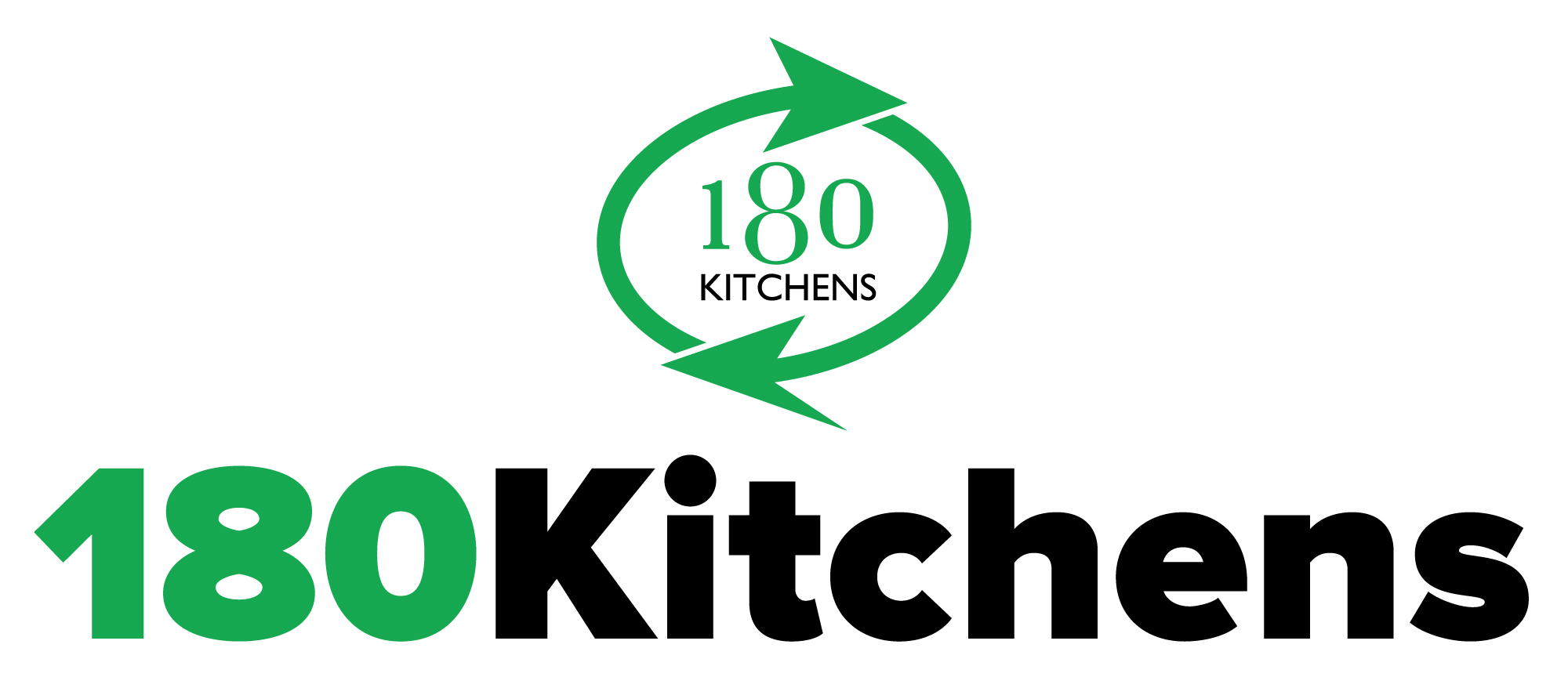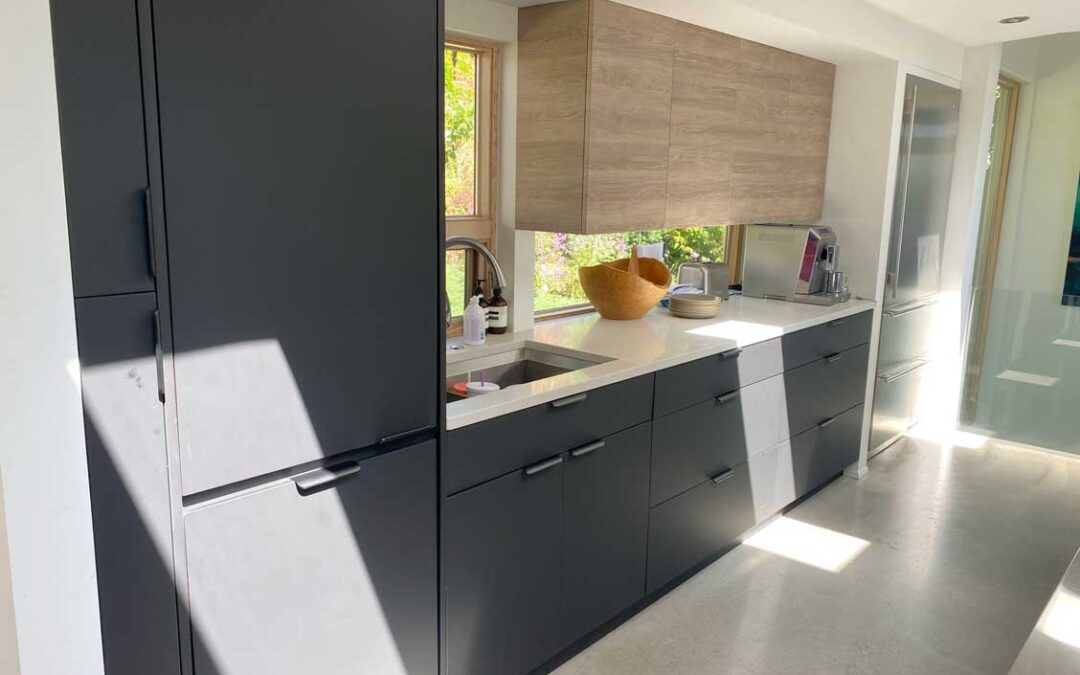If “home is where the heart is” and “the kitchen is the heart of the home,” you can see how important your kitchen is. It reflects your taste and lifestyle; its design and aesthetic are significant to the tone of your entire home.
A key element in any kitchen is the cabinetry, which can dictate the overall feel and style of the space. With time and use, your cabinets can begin to show signs of wear and tear, and you may find yourself contemplating a makeover.
There are many options to consider in every aspect of kitchen renovation—style, materials, lighting, cabinets versus open shelves, counter tops, backsplashes, appliances. It can be overwhelming. 180 Kitchens can guide you through the decisions, starting with an elemental question: “Is it better to refinish or reface kitchen cabinets?” Let’s consider your options.
Understanding Cabinet Refacing and Cabinet Refinishing
Cabinet Refacing
Cabinet refacing retains existing cabinet boxes if they are structurally sound and replaces the cabinet doors and drawer fronts. The process also involves adding vinyl to the exterior of the cabinet boxes to match their new doors. Cabinet refacing is ideal for those who want significant aesthetic changes without changing the existing kitchen layout. It’s also a great choice for those who want to completely redesign their kitchen.
Cabinet Refinishing
Cabinet refinishing strips cabinets of their existing finish, whether paint or stain and applies a fresh layer. It’s ideal for wood cabinets that are still in good condition, but it’s time and labour intensive and requires periodic touch-ups.
Which Is Better for You?

The first thing to do when deciding whether to opt for cabinet refacing or refinishing is to assess the condition of your current cabinets.
If your cabinets are structurally sound, with minimal cosmetic damage such as minor scratches or fading paint, refinishing may be what you want. It allows you to improve the appearance of your existing cabinets and avoid the cost of completely replacing them. All you’ll need to do is empty your cabinets and prepare them for painting (remove the doors and hardware, degrease, fill scratches and dents, sand); buy and spread drop cloths; buy filler, primer, paint, brushes, rollers, and masking tape (unless you want your walls and cabinets the same colour); mix the paint (an electric drill with a mixing bit makes it easier); and spend days meticulously painting your cabinets before putting them back together. Don’t forget the second coat! If your cabinets are laminate, you may be able to paint them with specific paint and supplies.
But if your cabinets are damaged, or outdated, or you wish to alter the design and style completely, cabinet refacing would be the better option. You can choose a new design, material, and colour for your cabinetry, resulting in a more dramatic transformation of your kitchen space.
Cabinet refacing is, admittedly, more expensive than painting or staining; it is also up to 50% less than the cost of replacement. Refacing gives you plenty of options to meet your design needs and budget. With 20 door styles and more than 40 colours to choose from—even wood grains—you will find the exact finish to suit your taste and lifestyle.
More about Cabinet Refacing vs Cabinet Refinishing
Each option has its set of advantages and potential drawbacks, which should be considered before deciding which path to take.
Advantages of Cabinet Refinishing
- Cost-Effective: Cabinet refinishing is generally more affordable than refacing, making it an ideal option for those seeking a budget-friendly kitchen makeover.
- Customizable: With cabinet refinishing, you can customize the look of your cabinets with various paint colors, stains, and finishes.
Disadvantages of Cabinet Refinishing
- Limited Materials: Not all cabinet materials can be refinished. Cabinets made from thermofoil, laminate, or other non-wood materials may not be suitable for refinishing.
- Doesn’t Fix Major Damage: Refinishing won’t address any structural issues with your cabinets. If your cabinets are damaged, refacing or replacing may be a better option.
- Time-Consuming: While refinishing can be a DIY project, it requires a significant amount of time and patience. The process involves thorough cleaning, sanding, and multiple layers of paint or stain.
Cabinet Refacing
- Completely Transforms Cabinets: Cabinet refacing allows for a complete transformation of your kitchen cabinets without altering the existing layout, but custom changes and additions are available.
- Long-Lasting Results: New cabinet doors are likely to last 15-20 years, providing a long-term solution for your kitchen renovation.
- Corrects Major Damage: If your existing cabinets are suffering from considerable wear and tear, refacing provides an opportunity to correct these issues while updating the look of your kitchen.
180 Kitchens Is The Way To Go!
Refacing with 180 Kitchens takes the worry and work out of your hands. Our installers and designers have combined experience of more than 20 years. There are many options available when you reface, including changing the layout; adding new features like pull-outs, drawers, or an island; increasing cabinet height; upgrading storage; and more.
Much of the process happens off-site, so you won’t be without your kitchen for more than a day or two, if that; we do our best to work with your schedule so you may not even be without kitchen access. 180 Kitchens is committed to keeping construction waste out of the landfill—we’ll keep the cabinet boxes and shelves that are still whole and sound and recycle everything we can.
180 Kitchens will help you turn your space around! Contact us in Greater Vancouver or the Edmonton area for more information or to get a free quote.


Recent Comments